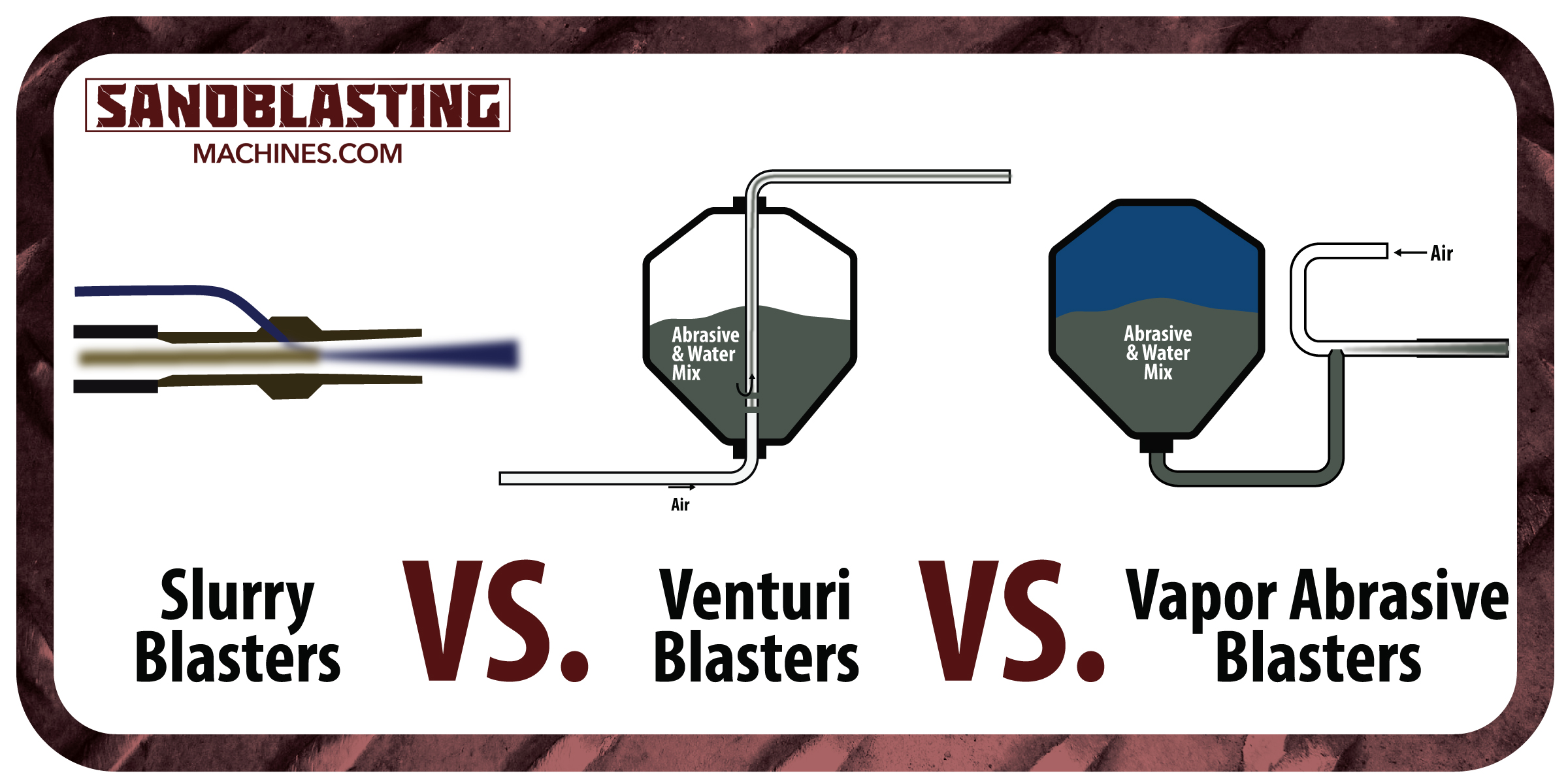Slurry Blast, Venturi Blast, and Vapor Blasting
By on Jun 4th 2018
Recently, the Media Blast Industry has had to make some changes to address air quality concerns in unconfined blast areas.
When working outside, it is very difficult to contain dust. This is not only an environmental concern but also a potential health concern to people nearby that are not wearing any respiratory protection. Take, for example, a contractor removing painted lines in the parking lot of a shopping center. While he or she may be protected by wearing a respirator, the patrons of the shopping center would not be. The dust given off would be more than just a nuisance by getting all over the customer's cars. The air the customers breathe could contain harmful particles from both the media being used and the surface being blasted.
Understanding this problem, the industry responded with Wet Blasting.
What is Wet Blasting?
Wet Blasting is in direct response to air quality concerns from media blasting. The State of California monitors air quality concerns by placing visibility requirements in areas where work is being done. The San Joaquin Valley Air Pollution Control District requires 40% Opacity in unconfined blasting areas (you can read more on this topic here).
By introducing water to the media, less dust is produced. While it is impossible to suppress all dust particles given off, the amount created when Wet Blasting is significantly reduced.
Different blast machine manufacturers have come up with different ways of delivering wet media. Three of the most common ways are Slurry Blasting, Venturi Blasting, and Vapor Blasting.

Venturi Blasters
Venturi Blasters store both media and water inside the blast pot. This type of setup takes away valuable real estate within the blast pot for media to be stored. This inefficiency reduces blast time due to low media storage.
You also need a careful balance of water and media within the pot. If you add too much water, you end up with a pressure washer on steroids. Add too little water and you end up with a clogged system.
Venturi Blasters force a stream of high-pressure air through the pot, carrying with it the media and water mixture out to the blast hose. Venturi blasters are only effective at high pressures, so blasting delicate surfaces like wood or thin metals will not work.
Vapor Abrasive Blasters
Similar to Venturi Blasters, Vapor Abrasive Blasters also use a mixture of water and media within the blast pot. The delivery of this mix is what differentiates the two. Vapor Blasters use water pressure within the pot to force the mix out and into the blast hose where it is then carried out to the nozzle by air pressure. Vapor Blasters can be used at lower pressures since the water pressure is what is forcing the mix out of the pot. However, you still need to be mindful of your initial mix of media and water, and not to mention what you do with any unused media and water within the pot when the job is complete.
Slurry Blasters
Slurry Blasters take traditional dry blasting technology and add water for dust suppression. The way in which the media is wet down is what makes them different from the other systems.
Clemco recently came out with their WetBlast Flex system. This unit is filled with traditional “dry” media and water is introduced outside of the blast pot. This allows you to take full advantage of the blast pot's media capacity.
There are several ways in which the water is introduced to the media stream. Utilizing Clemco’s Wet Blast Injector, water can be introduced just past the media valve via the Base Injector Unit. This allows the media and water to mix together within the blast hose as it is being carried out to the nozzle. The only disadvantage to this is that the amount of water being introduced must be dialed in before blasting. If that is a problem, Clemco has already addressed it with the Nozzle Injector System. This introduces water out at the nozzle just before the nozzle holder. There is a valve located literally at the operator's fingertips so that the precise amount of water needed can be dialed in on the fly.
The WetBlast Flex also has two ways of delivering water to the Wet Blast Injector. For contractors working in remote areas where water may not be accessible, the Flex includes a 120-gallon water tank. Turning down jobs due to the lack of a water source is no longer a concern. For jobs where “City Water” is readily available, you can simply hook the Wet Blast injector up to a regular garden hose. With all these options, it should be pretty clear how Clemco came up with the name Flex.
Finally, what is probably one of the greatest features of the WetBlast Flex is that it can still be used as a dry blaster. This is not an option on a Venturi or Vapor System—at least not on the fly. So, if you are working on something where dust suppression is not a concern, simply turn off the water at the nozzle. Now you have a traditional “Dry Blaster”. You can also blast with just water and air to rinse off any surfaces you have been prepping by turning off the media flow via the Abrasive Cut-Off Switch (ACS) and having the water valve open. Lastly, you can switch the WetBlast Flex into blow down mode by turning off the ACS and water valve. This makes drying off any surface a breeze.
So, if you are in the market for a Wet Blast System, be sure to do your homework. There are a lot of options out there and it is a significant investment, so pick the one that is right for you and your needs. If you are up in the air, you can always choose the WetBlast Flex offered by Clemco. With all of its features, it is pretty hard to go wrong.
If you have any questions regarding the WetBlast Flex or any Clemco blast machines, be sure to reach out to us at SandBlastingMachines.com.






